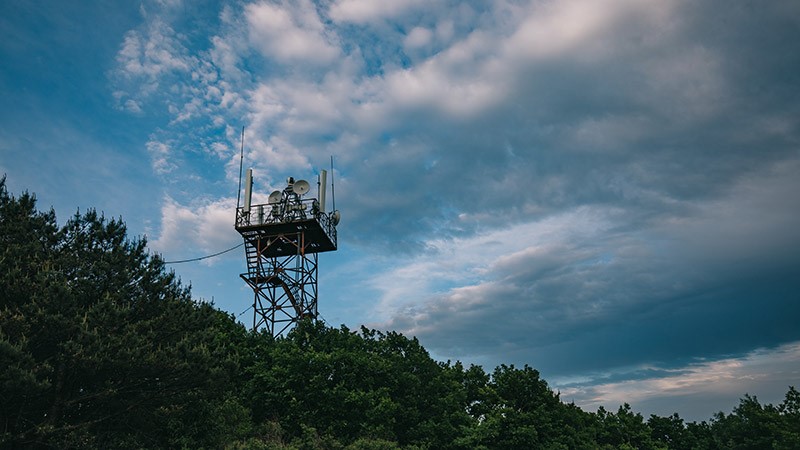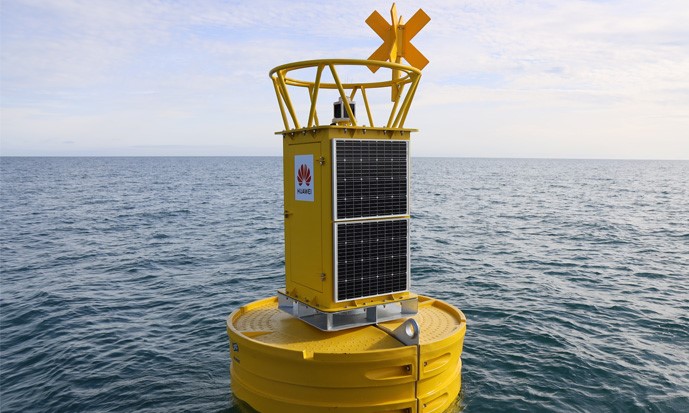Huawei contributes to global ecological and environmental protection with technological innovations
In recent years, Chinese telecom giant Huawei has actively participated in global biodiversity protection, safeguarding lucid waters and lush mountains with technological innovations.

Chinese telecom giant Huawei builds an LTE (Long Term Evolution) base station in the Northeast China Tiger and Leopard National Park spanning northeast China’s Jilin and Heilongjiang provinces on the original fire lookout tower of the park to avoid impact on nature. (Photo/www.huawei.com)
In May 2020, the Northeast China Tiger and Leopard National Park in northeast China’s Jilin and Heilongjiang provinces frequently reported good news of rare and precious wild animals, including capturing white roe deer on film twice and finding traces of wild Siberian tiger.
It is because of a space-air-ground integrated monitoring system established in the park that the images of such rare and precious wild animals have been captured and made available to the public.
The monitoring system includes a three-tier architecture covering information collection, real-time information transmission, and data analysis and processing, according to Du Juan, director of Huawei’s TECH4ALL digital inclusion office.
Huawei has taken part in the development a 700MHz integrated wired and wireless LTE (Long Term Evolution) bearer network, the underlying part that plays a key role in the system, Du said.
By making use of the original fire lookout tower of the park in the deployment of the 700MHz network, the company has managed to minimize the environmental impact of the installation of the network while enabling it to cover a wider area of the park and reduce to the greatest extent the number of visits to the mountains in the park by scientists and rangers, said Zhao Xinsheng, an engineer with Huawei.
The network can achieve real-time transmission of images and high-definition videos from infrared cameras installed for wildlife protection, collection and transmission of ecological factor data from sensors that can monitor the condition of soil, water, air, etc., and real-time check on rangers’ patrol routes, according to Zhao.

Photo shows a buoy deployed in waters off Baltimore village in County Cork, Ireland, under the Smart Whale Sounds project sponsored by Chinese telecom giant Huawei’s branch in Ireland. The buoy can continuously monitor the sounds of cetaceans in the areas covered by the project. (Photo/www.huawei.com)
The space-air-ground integrated monitoring system has covered all the areas of the Northeast China Tiger and Leopard National Park, realizing accurate and intelligent monitoring, assessment, and management of rare and precious wild animals and natural resources.
The growing maritime traffic off the south coast of Ireland caused by container vessels, pleasure boats and speedboats, among other water vessels, has not only increased noise pollution and affected marine animals’ habit of using sound to communicate, but increased the danger of accidental damage to them by ships.
In March this year, a project named Smart Whale Sounds, for which Huawei has provided technical support, kicked off in the south coast of Ireland. By identifying the sounds of whales, dolphins, and other marine animals, the project studies the impacts of the growing marine noise pollution.
According to Huawei, the Smart Whale Sounds project deployed a buoy, which is about four meters long and weighs two tons, in waters off Baltimore village in County Cork, Ireland. Equipped with an underwater microphone, the buoy can continuously monitor the sounds of cetaceans in the areas covered by the project.
The acoustic monitoring systems of the project collect acoustic data on cetaceans and carry out rapid analysis of these data by leveraging technologies in such fields as cloud platform and artificial intelligence (AI) algorithm, thus classifying the sounds of marine animals and identifying their species to acquire information about their behavioral rules, said an executive of the project who works for Huawei.
In the future, these data will be provided for relevant authorities to help with spatial planning and usage of marine protected areas, the executive added.
In Grosseto, Italy, there is a wetland consisting of sand dunes and Mediterranean forests, which is inhabited by more than 300 species of birds. However, poaching, illegal logging, and unauthorized intrusion have severely impacted the ecological environment of the wetland.

Photo shows workers installing Guardian system, an ecological acoustic monitoring system developed by Chinese telecom giant Huawei, in the Palawan rainforest in the Philippines. (Photo/www.huawei.com)
Since 2019, Huawei and the nonprofit technology startup Rainforest Connection (RFCx) jointly developed Guardian, an acoustic monitoring system based on cloud and AI. Through sound collection devices with solar panels deployed in the wild, the Guardian system collects ambient sounds 24 hours a day, uploads data onto cloud platform in real-time via carrier’s communications network, and carries out data analysis and detection based on AI algorithms.
By sending messages to mobile app and online platform to alert rangers whenever any unusual sound of illegal intrusion is detected, such as the sounds of chainsaws or shotguns, the Guardian system has effectively helped crack down on activities that damage the wetland and create conditions for the conservation and restoration of the wetland.
With the support from Huawei, the Guardian system has been used in nearly 30 protected sites around the world. From tropical rainforests in the Philippines and Malaysia to Pindus National Park in Greece, from spider monkeys on the Osa Peninsula in Costa Rica to Darwin’s foxes in the Nahuelbuta National Park of Chile, the Guardian system “listens to” and analyzes the changes in nature and provides scientists with data support.
Because of its active efforts to protect nature and stop biodiversity loss caused by human activities, the “Nature Guardian” project, under which the Guardian system was developed, received the GSMA 2021 GLOMO for Outstanding Mobile Contribution to the UN SDGs.
Photos
Related Stories
- 'Natural biological gene bank' in E China's Zhejiang
- China's top court publishes typical biodiversity protection cases
- Chinese customs seize 4-meter-long live king cobra
- In pics: Karoo National Park in South Africa
- Photographs of wildlife along Yangtze River on display in C China
- Chinese researchers develop AI-aided tech for snow leopard protection
Copyright © 2021 People's Daily Online. All Rights Reserved.










